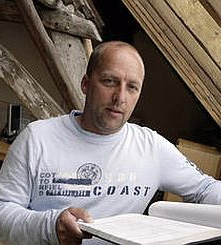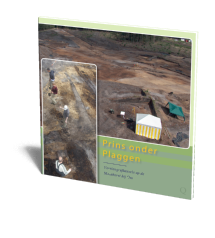Abstract:
Some 2800 years ago, a man died in what is now the municipality of Oss, the Netherlands. His death must have been a significant event in the life of local communities, for he received an extraordinary funeral, which ended with the construction of an impressive barrow.
Based on the meticulous excavation and a range of specialist and comprehensive studies of finds, a prehistoric burial ritual now can be brought to life in surprising detail. An Iron Age community used extraordinary objects that find their closest counterpart in the elite graves of the Hallstatt culture in Central Europe. This book will discuss how lavishly decorated items were dismantled and taken apart to be connected with the body of the deceased, all to be destroyed by fire. In what appears to be a meaningful pars pro toto ritual, the remains of his body, the pyre, and the objects were searched through and moved about, with various elements being manipulated, intentionally broken, and interred or removed. In essence, a person and a place were transformed through destruction.
The book shows how the mourners carefully, almost lovingly covered the funeral remains with a barrow. Attention is also given to another remarkable monument, long mound 6, located immediately adjacent to mound 7. Excavations show how mound 7 was part of an age-old ritual heath landscape that was entirely restructured during the Early Iron Age, when it became the setting for the building of no less than three huge Hallstatt C barrows. Thousands of years later, during the Late Middle Ages, this landscape underwent a complete transformation of meaning when the prehistoric barrows became the scenery for a macabre display of the cadavers of executed criminals.
This publication is part of the Ancestral Mounds Research Project of the University of Leiden: overview of the other Ancestral Mounds-publications


Dr.
Richard Jansen
Richard Jansen is fulltime lecturer in Applied Archaeology and European Prehistory at the Faculty of Archaeology, University of Leiden. Between 2008 and 2018 he also was the municipal-archaeologist of Oss. His (PhD-)research focused on the long-term structuring of the (settlement) landscape from the late prehistory until the Roman Period, especially on the extensively researched sandy soils of Oss, but also within the larger MSD-region.
read more


Dr.
Sasja van der Vaart-Verschoof
Sasja van der Vaart-Verschoof is a freelance consultant, researcher and editor known as the Overdressed Archeologist & Editor. In addition to publishing half a dozen books with us, she frequently collaborates with Sidestone Press doing both copy editing, book design and our social media marketing.
read more


Prof. dr.
David Fontijn
David Fontijn (1971-2023) was professor in the Archaeology of Early Europe at the Faculty of Archaeology, University of Leiden, the Netherlands. His research dealt with the early agrarian societies of Europe from prehistory up until the early historical period, with a particular focus on the Bronze and (early) Iron Age, the exchange and deposition of metalwork and the archaeology of so-called ritual landscapes. He led the NWO-VICI project ‘Economies of Destruction’ investigating the puzzling destruction of valuable objects in Bronze Age Europe (2015-).
read more














